The “Comments Moderation” dashboard allows you to manage all the comments that have been posted on your posts/pages. In this article, we’ll go over each option found in this dashboard.
Set Up Who Can Moderate Comments
Not every user from your website can have access to the “Comments Moderation” dashboard. In fact, you can determine who can moderate comments by accessing the “Advanced Settings” of your Thrive Comments plugin:

Also, before you start using this feature, don’t forget to set up your WordPress settings that determine what happens on the comment moderation side.
To configure that, you have to go to the “Discussion” section of your WordPress settings:

And make the necessary settings here, depending on how you would like to moderate the comments made on the website:
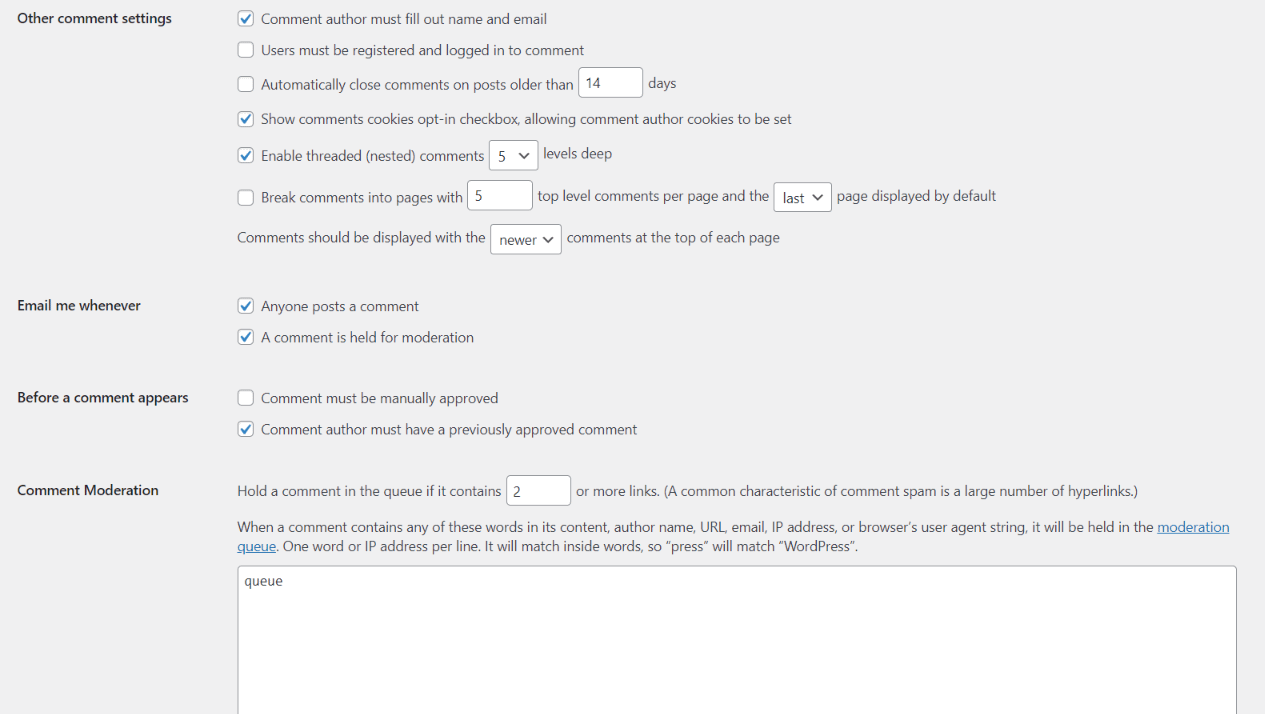
Accessing the Comments Moderation
In order to access the feature, head over to your Thrive Comments:
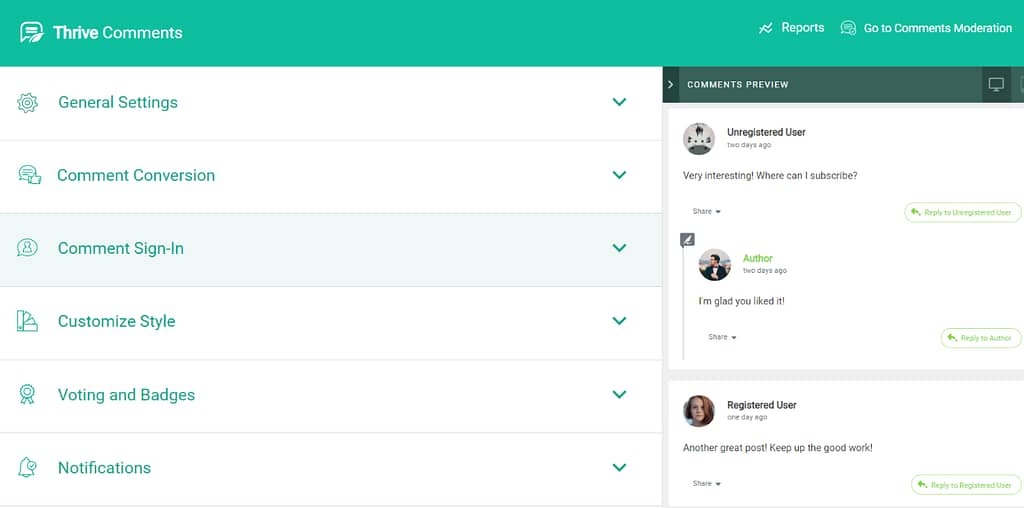
And here, click on “Go to Comments Moderation” in the top right-hand corner of the page:

Also, you can access it directly from the WordPress admin dashboard, by hovering over “Comments” and then selecting “Thrive Comments Moderation” from the sub-menu that opens:
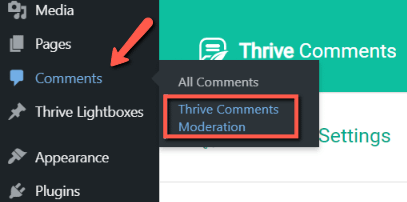
Keyboard Shortcuts
You can make your work a lot easier by making use of the keyboard shortcuts that are available in Thrive Comments:

Click on “Display Keyboard Shortcuts” to view all shortcuts, or simply press “Ctrl+K”:
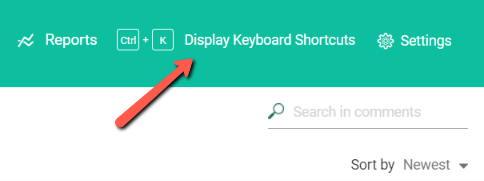
This will basically open up a lightbox with all the available keyboard shortcuts:

Important!
This is how the shortcuts work: for each action, the letter that is underlined (e.g. Unapprove – “U”) is the keyboard shortcut:

So you only have to keep an eye out for the underlined letters of each action, and then use the shortcut to perform that action with the help of the keyboard.
Find Comments More Easily
You next have the option to view only comments from a certain post/page, or you can choose to view all comments from your website at once:
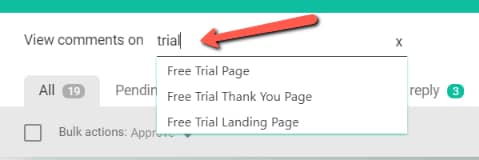
As you can see, the search bar comes in handy if you want to look up a particular post or page.
You can also find another search bar on the top right-hand corner of the page. With this you can search actual comments, by typing in keywords that are found in the comments:
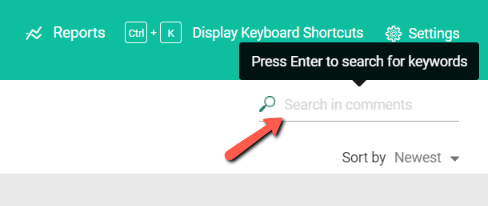
Filtering Options
Below, you have a few filter options. So, if you choose, you can view only the following categories of comments:

- Pending: The comments that are awaiting moderation will be listed here (if you have set your comments to be manually approved first, before appearing on your website)
- Unreplied: All the comments that are waiting for a reply will be listed here. (read more about “No Reply Needed / Needs Reply” in the following sections of this article)
- Pending my reply: A comment will be listed here if it has been delegated to you and it’s waiting for a reply. (Find out what delegating a comment means in the following sections of this article)
- Featured: Any comment that will be set as “Featured” will be listed here. These comments will be pinned to the top of the list of comments, on the blog post.
- Spam: Any “Spam” flagged comment will be listed here.
- Trash: All comments that were deleted can be found in this section
On the right-hand side, you can also sort your comments by “Oldest/Newest”:
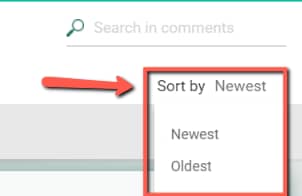
Bulk Actions
Underneath the filtering options, you will find specific bulk actions. If you click on the checkbox from the left of “Bulk actions”, it will select all the comments you see on the dashboard at that point:
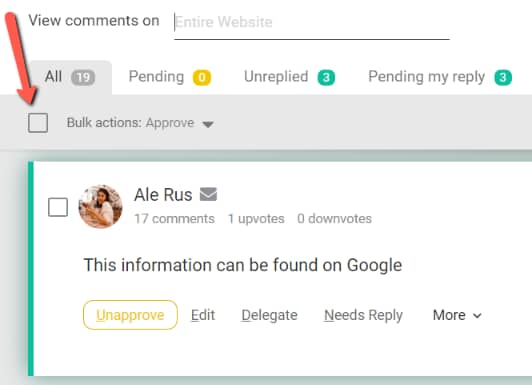
However, if you select only one or more comments individually, the “Bulk actions” checkbox will turn into a dash icon, and if you click on it once more, the selected comment will be deselected. Here’s how that works:
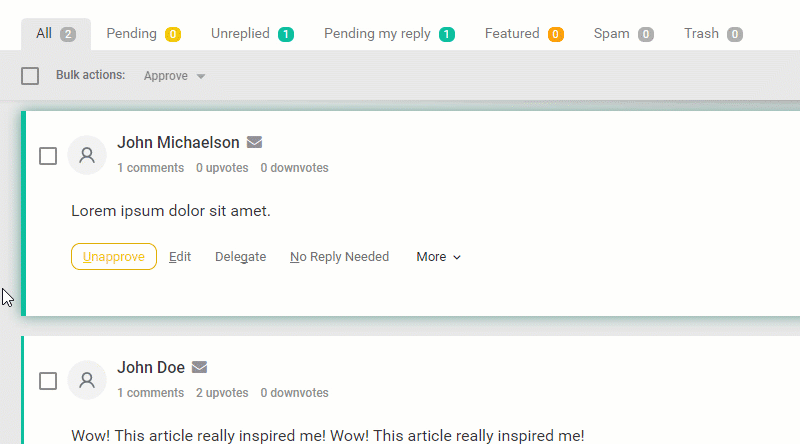
Feel free to use the bulk actions whenever you want to modify multiple comments at once.
Comment Options & Information
Moving on, you get to the part where the comments are listed:

This is an example of a comment that is awaiting moderation and it isn’t visible on the website just yet. This is only possible if you have set in your WordPress settings that a comment must be manually approved before it’s displayed on your site.
Basic Information (Name, Email, Comment Content, etc.)
As you can see, you have the following information available for the comment:
- The name of the visitor that has submitted the comment.
- The email address – visible on hover over the mail icon next to the name:
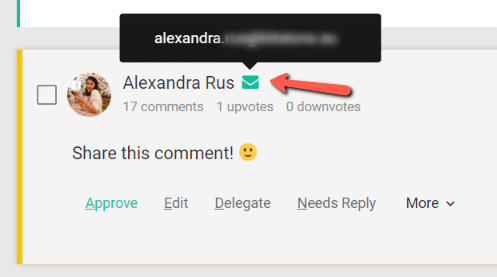
- The avatar of the user/visitor – which can be defined in the “Customize Style” section.
- Number of comments the user has posted on your website.
- The voting status for the user (e.g. x upvotes, y downvotes) – if the user has multiple comments posted on your site, the total number of upvotes and downvotes will be displayed here.
- The time when the comment was posted and on which page/post it was posted.
- Options to view post, view comments for that post only, and edit post:

- The actual content of the comment (e.g. “Lorem ipsum dolor sit amet”).
- If a user will reply to another user’s comment. The original comment will be displayed on the right-hand side, with the note “In reply to: <user name>”:

Moderation Options (Approve, Delegate, Reply, etc.)
Below the content of the comment, you get a few more important options:

- You can approve/unapprove a comment – if a comment is unapproved, it will be sent to the “Pending” list, and it will also be flagged as “Awaiting Moderation”.
- Then, the comment can be edited, similar to the WordPress “Comment Moderation” options.
- Delegate – this means that a comment can be assigned to a certain moderator:
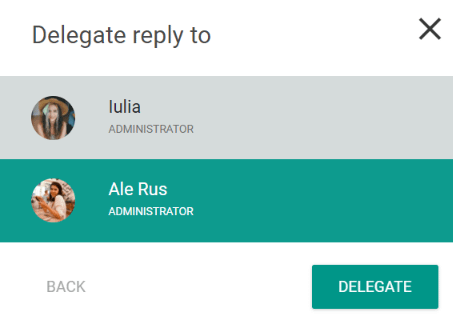
After assigning a comment to a certain moderator, it will be listed in the “Pending my reply” list. Also, the comment will carry the message “Assigned to <moderator name>”.
- No Reply Needed / Needs Reply – if the comment needs a reply, it will appear in the “Unreplied” list. However, if you decide that it doesn’t need a reply, you can click on “No Reply Needed” and will be removed from this list.
A comment from a visitor will automatically be flagged with “Needs Reply”. When the comment receives a reply, the message will automatically change to “No Reply Needed”.
The comments from moderators, if they show up in the dashboard, will be flagged, by default, with “No Reply Needed”.
- More – this will open up a drop-down with more options for the comment:

Feature – this will mark the comment on the front-end, as an important one.
Spam / Trash – this will move a comment into the Spam / Trash list.
Save as Testimonial – with this option you can simply transform any comment into a testimonial. Select the option, fill in the form that will open up, click on “Add Testimonial” and it will be added to your Thrive Ovation dashboard.
- Reply – you can reply to a comment directly from this dashboard if you want:

Note: You can use just the keyboard for the entire step if you want. To start writing your reply, simply press “R”. Then, when you have finished your reply message, press “Tab”, and then “Enter”. Just like that, the reply has been submitted!
Front-End Moderation
You can also apply a few basic moderation options on the comments, directly from the actual post / page where they were posted.
All you need to do is access the specific post/page where the comments have been posted, scroll down till you find the comment, and look for the three dots on the right-hand side:

Hopefully, this article about how to navigate the comment moderation dashboard was useful to you. Make sure to check out other tutorials from this section, that are available in our knowledge base.